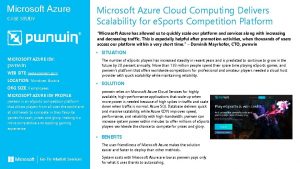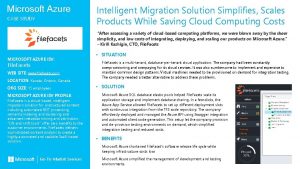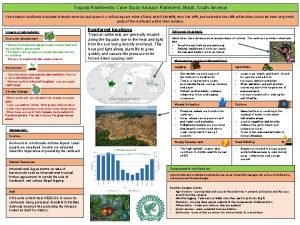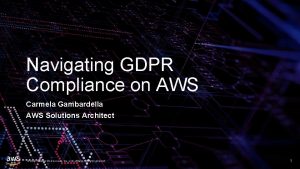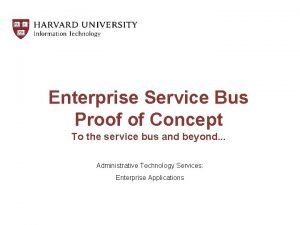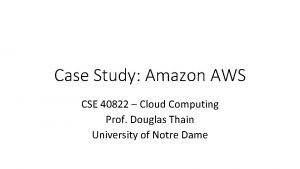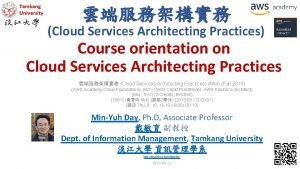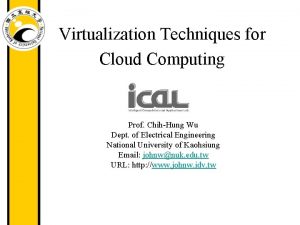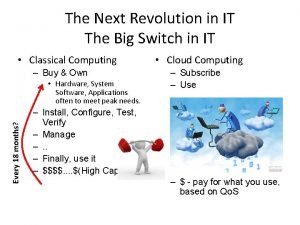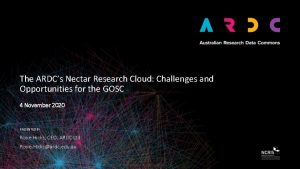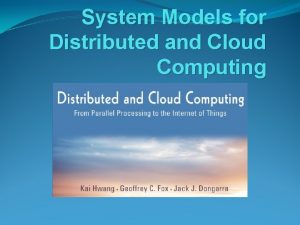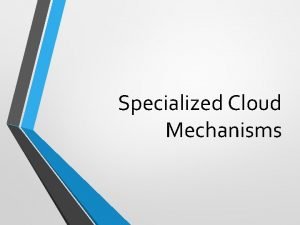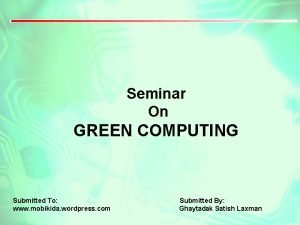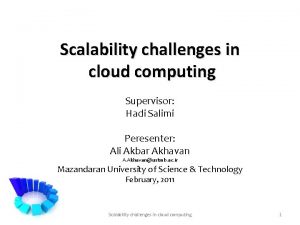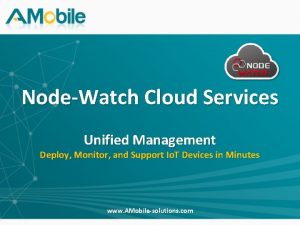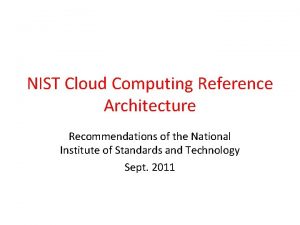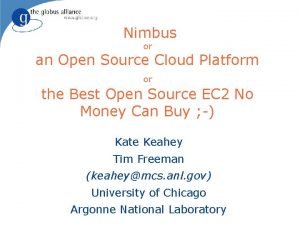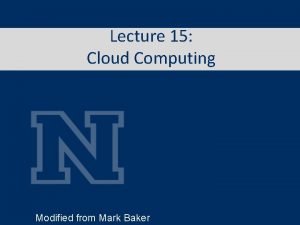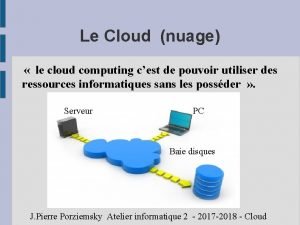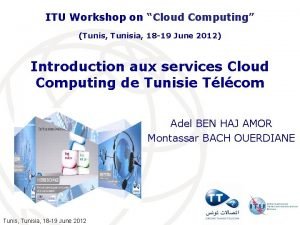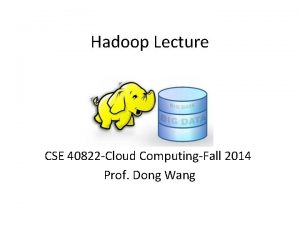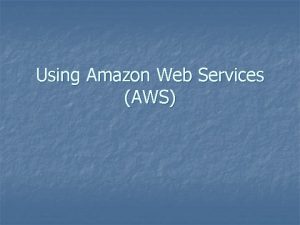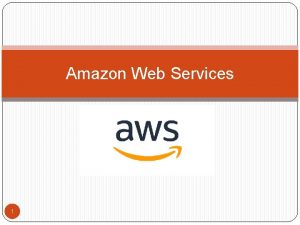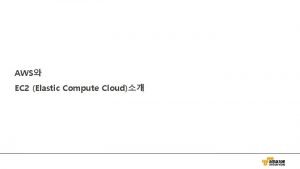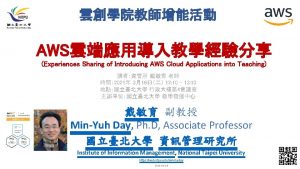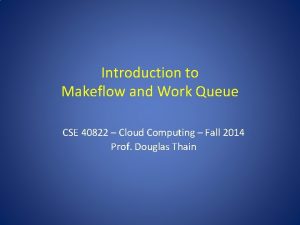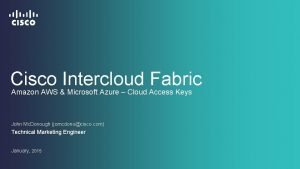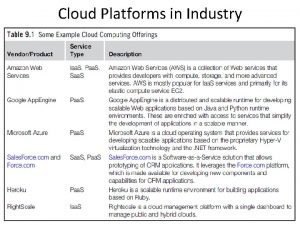Case Study Amazon AWS CSE 40822 Cloud Computing

































- Slides: 33

Case Study: Amazon AWS CSE 40822 – Cloud Computing Prof. Douglas Thain University of Notre Dame

Caution to the Reader: Herein are examples of prices consulted in October 2014, to give a sense of the magnitude of costs. Do your own research before spending your own money!

Several Historical Trends • Shared Utility Computing • 1960 s – MULTICS – Concept of a Shared Computing Utility • 1970 s – IBM Mainframes – rent by the CPU-hour. (Fast/slow switch. ) • Data Center Co-location • 1990 s-2000 s – Rent machines for months/years, keep them close to the network access point and pay a flat rate. Avoid running your own building with utilities! • Pay as You Go • Early 2000 s - Submit jobs to a remote service provider where they run on the raw hardware. Sun Cloud ($1/CPU-hour, Solaris +SGE) IBM Deep Capacity Computing on Demand (50 cents/hour) • Virtualization • 1960 s – OS-VM, VM-360 – Used to split mainframes into logical partitions. • 1998 – VMWare – First practical implementation on X 86, but at significant performance hit. • 2003 – Xen paravirtualization provides much perf, but kernel must assist. • Late 2000 s – Intel and AMD add hardware support for virtualization.

Virtual-* Allows for the Scale of Abstraction to Increase Over Time • Run one process within certain resource limits. Op Sys has virtual memory, virtual CPU, and virtual storage (file system). • Run multiple processes within certain resource limits. Resource containers (Solaris), virtual servers (Linux), virtual images (Docker) • Run an entire operating system within certain limits. Virtual machine technology: VMWare, Xen, KVM, etc. • Run a set of virtual machines connected via a private network. Virtual networks (SDNs) provision bandwidth between virtual machines. • Run a private virtual architecture for every customer. Automated tools replicate virtual infrastructure as needed.

Amazon AWS • Grew out of Amazon’s need to rapidly provision and configure machines of standard configurations for its own business. • Early 2000 s – Both private and shared data centers began using virtualization to perform “server consolidation” • 2003 – Internal memo by Chris Pinkham describing an “infrastructure service for the world. ” • 2006 – S 3 first deployed in the spring, EC 2 in the fall • 2008 – Elastic Block Store available. • 2009 – Relational Database Service • 2012 – Dynamo. DB • Does it turn a profit?


Terminology • Instance = One running virtual machine. • Instance Type = hardware configuration: cores, memory, disk. • Instance Store Volume = Temporary disk associated with instance. • Image (AMI) = Stored bits which can be turned into instances. • Key Pair = Credentials used to access VM from command line. • Region = Geographic location, price, laws, network locality. • Availability Zone = Subdivision of region the is fault-independent.


EC 2 Pricing Model • Free Usage Tier • On-Demand Instances • Start and stop instances whenever you like, costs are rounded up to the nearest hour. (Worst price) • Reserved Instances • Pay up front for one/three years in advance. (Best price) • Unused instances can be sold on a secondary market. • Spot Instances • Specify the price you are willing to pay, and instances get started and stopped without any warning as the marked changes. (Kind of like Condor!) http: //aws. amazon. com/ec 2/pricing/

Free Usage Tier • 750 hours of EC 2 running Linux, RHEL, or SLES t 2. micro instance usage • 750 hours of EC 2 running Microsoft Windows Server t 2. micro instance usage • 750 hours of Elastic Load Balancing plus 15 GB data processing • 30 GB of Amazon Elastic Block Storage in any combination of General Purpose (SSD) or Magnetic, plus 2 million I/Os (with Magnetic) and 1 GB of snapshot storage • 15 GB of bandwidth out aggregated across all AWS services • 1 GB of Regional Data Transfer




Surprisingly, you can’t scale up that large.

Simple Storage Service (S 3) • A bucket is a container for objects and describes location, logging, accounting, and access control. A bucket can hold any number of objects, which are files of up to 5 TB. A bucket has a name that must be globally unique. • Fundamental operations corresponding to HTTP actions: • • • http: //bucket. s 3. amazonaws. com/object POST a new object or update an existing object. GET an existing object from a bucket. DELETE an object from the bucket LIST keys present in a bucket, with a filter. • A bucket has a flat directory structure (despite the appearance given by the interactive web interface. )

Easily Integrated into Web Applications <form action="http: //examplebucket. s 3. amazonaws. com/" method="post" enctype="multipart/form-data"> <input type="input" name="key" value="user/user 1/" /> <input type="hidden" name="acl" value="public-read" /> <input type="hidden" name="success_action_redirect" value="http: //examplebucket. s 3. amazonaws. com/successful_upload. html" />. . . <input type="text" name="X-Amz-Credential” value="AKIAIOSFODNN 7 EXAMPLE/20130806/us-east-1/s 3/aws 4_request" />. . . <input type="submit" name="submit" value="Upload to Amazon S 3" /> </form> http: //docs. aws. amazon. com/Amazon. S 3/latest/API/sigv 4 -post-example. html

Bucket Properties • Versioning – If enabled, POST/DELETE result in the creation of new versions without destroying the old. • Lifecycle – Delete or archive objects in a bucket a certain time after creation or last access or number of versions. • Access Policy – Control when and where objects can be accessed. • Access Control – Control who may access objects in this bucket. • Logging – Keep track of how objects are accessed. • Notification – Be notified when failures occur.

S 3 Weak Consistency Model Direct quote from the Amazon developer API: “Updates to a single key are atomic…. ” “Amazon S 3 achieves high availability by replicating data across multiple servers within Amazon's data centers. If a PUT request is successful, your data is safely stored. However, information about the changes must replicate across Amazon S 3, which can take some time, and so you might observe the following behaviors: • A process writes a new object to Amazon S 3 and immediately attempts to read it. Until the change is fully propagated, Amazon S 3 might report "key does not exist. " • A process writes a new object to Amazon S 3 and immediately lists keys within its bucket. Until the change is fully propagated, the object might not appear in the list. • A process replaces an existing object and immediately attempts to read it. Until the change is fully propagated, Amazon S 3 might return the prior data. • A process deletes an existing object and immediately attempts to read it. Until the deletion is fully propagated, Amazon S 3 might return the deleted data. ”




Elastic Block Store • An EBS volume is a virtual disk of a fixed size with a block read/write interface. It can be mounted as a filesystem on a running EC 2 instance where it can be updated incrementally. Unlike an instance store, an EBS volume is persistent. • (Compare to an S 3 object, which is essentially a file that must be accessed in its entirety. ) • Fundamental operations: • • CREATE a new volume (1 GB-1 TB) COPY a volume from an existing EBS volume or S 3 object. MOUNT on one instance at a time. SNAPSHOT current state to an S 3 object.



EBS is approx. 3 x more expensive by volume and 10 x more expensive by IOPS than S 3.

Use Glacier for Cold Data • Glacier is structured like S 3: a vault is a container for an arbitrary number of archives. Policies, accounting, and access control are associated with vaults, while an archive is a single object. • However: • • All operations are asynchronous and notified via SNS. Vault listings are updated once per day. Archive downloads may take up to four hours. Only 5% of total data can be accessed in a given month. • Pricing: • Storage: $0. 01 per GB-month • Operations: $0. 05 per 1000 requests • Data Transfer: Like S 3, free within AWS. • S 3 Policies can be set up to automatically move data into Glacier.

Durability • Amazon claims about S 3: • Amazon S 3 is designed to sustain the concurrent loss of data in two facilities, e. g. 3+ copies across multiple available domains. • 99. 99999% durability of objects over a given year. • Amazon claims about EBS: • Amazon EBS volume data is replicated across multiple servers in an Availability Zone to prevent the loss of data from the failure of any single component. • Volumes <20 GB modified data since last snapshot have an annual failure rate of 0. 1% - 0. 5%, resulting in complete loss of the volume. • Commodity hard disks have an AFR of about 4%. • Amazon claims about Glacier is the same as S 3: • Amazon S 3 is designed to sustain the concurrent loss of data in two facilities, e. g. 3+ copies across multiple available domains PLUS periodic internal integrity checks. • 99. 99999% durability of objects over a given year. • Beware of oversimplified arguments about low-probability events!

Architecture Center • Ideas for constructing large scale infrastructures using AWS: http: //aws. amazon. com/architecture/

Command Line Setup • Go to your profile menu (your name) in the upper right hand corner, select “Security Credentials” and “Continue to Security Credentials” • Select “Access Keys” • Select “New Access Key” and save the generated keys somewhere. • Edit ~/. aws/config and set it up like this: [default] output = json region = us-west-2 aws_access_key = XXXXXX aws_secret_access_key = YYYYYY • Now test it: Note the syntax here is different from how it was given in the web console! AWSAccess. Key=XXXXXX AWSSecret. Access. Key=YYYYY aws ec 2 -describe-instances

S 3 Command Line Examples aws. . . s 3 aws s 3 mb cp mv ls rm rb s 3: //bucket localfile s 3: //bucket/key s 3: //bucket/newname s 3: //bucket/key s 3: //bucket help ls help

EC 2 Command Line Examples aws ec 2 describe-instances run-instances --image-id ami-xxxxx -- count 1 --instance-type t 1. micro --key-name keyfile stop-instances --instance-id i-xxxxxx help start-instances help

Warmup: Get Started with Amazon • Skim through the AWS documentation. • Sign up for AWS at http: //aws. amazon. com • (Skip the IAM management for now) • Apply the service credit you received by email. • Create and download a Key-Pair, save it in your home directory. • Create a VM via the AWS Console • Connect to your newly-created VM like this: • ssh -i my-aws-keypair. pem ec 2 -user@ip-address-of-vm • Create a bucket in S 3 and upload/download some files.

Demo Time http: //aws. amazon. com
 Case study on microsoft azure in cloud computing
Case study on microsoft azure in cloud computing Case study on microsoft azure in cloud computing
Case study on microsoft azure in cloud computing The amazon rainforest case study
The amazon rainforest case study Amazon and whole foods merger case study
Amazon and whole foods merger case study Ec2use
Ec2use Aws and gdpr
Aws and gdpr Amazon aws enterprise service bus
Amazon aws enterprise service bus Logw
Logw Computing refers to
Computing refers to Aws cse
Aws cse Aws academy cloud foundations (acf)
Aws academy cloud foundations (acf) Best worst and average case
Best worst and average case Hershey's erp failure
Hershey's erp failure Conventional computing and intelligent computing
Conventional computing and intelligent computing Vodafone the cloud business
Vodafone the cloud business Hardware assisted virtualization in cloud computing
Hardware assisted virtualization in cloud computing Virtualization ppt
Virtualization ppt Types of clouds in cloud computing
Types of clouds in cloud computing Cloud computing reference model
Cloud computing reference model Nectar cloud computing
Nectar cloud computing Explain system models for distributed and cloud computing
Explain system models for distributed and cloud computing Pay per use monitor
Pay per use monitor Seminar on green computing
Seminar on green computing Scalability issues in cloud computing
Scalability issues in cloud computing Elastic computing
Elastic computing Cloud unified management
Cloud unified management Cloud computing reference model
Cloud computing reference model Nimbus in cloud computing
Nimbus in cloud computing Cloud computing cambridge
Cloud computing cambridge Cloud computing layers
Cloud computing layers Regarder introduction to cloud computing
Regarder introduction to cloud computing Sejarah cloud computing
Sejarah cloud computing Kentico headless cms
Kentico headless cms Cloud computing tunisie
Cloud computing tunisie
